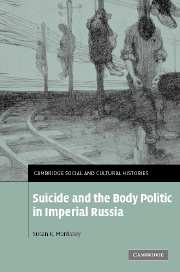Book contents
- Frontmatter
- Contents
- List of illustrations
- List of figures
- List of tables
- Acknowledgments
- Note on transliteration, translations, and dates
- List of abbreviations
- Introduction
- Part I Public order and its malcontents
- Part II Disease of the century
- Part III Political theology and moral epidemics
- 10 Freedom, death, and the sacred
- 11 Children of the twentieth century
- Epilogue
- Selected bibliography
- Index
10 - Freedom, death, and the sacred
Published online by Cambridge University Press: 18 July 2009
- Frontmatter
- Contents
- List of illustrations
- List of figures
- List of tables
- Acknowledgments
- Note on transliteration, translations, and dates
- List of abbreviations
- Introduction
- Part I Public order and its malcontents
- Part II Disease of the century
- Part III Political theology and moral epidemics
- 10 Freedom, death, and the sacred
- 11 Children of the twentieth century
- Epilogue
- Selected bibliography
- Index
Summary
Somehow I had gotten hold of Ryleev's poem “Nalivaiko,” and it became one of my holy relics. […] And I did indeed know Ryleev's fate. Everywhere, heroism, struggle, and revolt were always connected with suffering and death. “There are times, indeed entire epochs, when there can be nothing as beautiful and desirable as a crown of thorns.”
Vera Zasulich, quoting the executed Decembrist poet Kondratii Ryleev, Reminiscences, 1931Violent death and self-willed death are closely connected.
L. Prozorov, “Suicides of the Condemned,” 1911In 1879, a young man, identified in the newspaper report only as Somov, killed himself while in prison. Arrested in Odessa for making a revolutionary speech, he had been restrained and placed in solitary confinement due to unspecified disruptive behavior. Using his teeth to maneuver the lamp, he then set his clothes on fire and lay down on his straw mattress. Only the coils of smoke escaping the grate in the door alerted his jailers, who found him engulfed in flames and immediately tried to save him. Despite tremendous physical pain, it was reported, he did not let out a moan, though he survived for several days, his hands and back completely charred away. This silence, noted here in passing, resonated with unspoken significance.
Such events became increasingly common over the next decades, though the strict censorship imposed following the assassination of Alexander II usually prevented their full public exposure.
- Type
- Chapter
- Information
- Suicide and the Body Politic in Imperial Russia , pp. 273 - 311Publisher: Cambridge University PressPrint publication year: 2007

